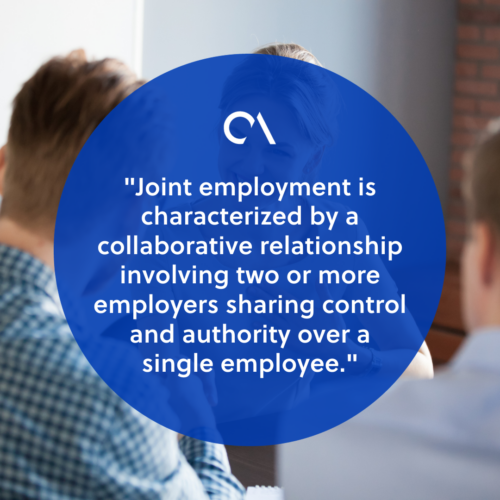Co-employment vs. Joint employment: Differences explained

Today’s workplace is undergoing a noticeable shift with the introduction of new technologies and employment types.
One driving factor is the rise of the gig economy, propelled by digital platforms that connect workers with short-term or project-based opportunities.
Additionally, the growing recognition of diverse workstyles and preferences has led to alternative employment models, such as co-employment and joint employment.
This article delves into the depths of co-employment vs. joint employment, exploring their definitions, key differences, and implications for businesses and employees.
What is co-employment?
Co-employment is a unique employment arrangement where two entities share the responsibilities and liabilities of employing a single worker.
In this model, a primary employer—typically a staffing agency or professional employer organization (PEO)—handles certain aspects of employment.
These aspects are:
- Payroll
- Benefits administration
- HR management
Meanwhile, the secondary employer, often a client or worksite, maintains control over the day-to-day activities and tasks of the employee.

What is joint employment?
In contrast, joint employment involves two or more employers sharing control and authority over an employee.
Each employer has a direct and immediate relationship with the worker in this arrangement. They also collectively determine the terms and conditions of employment.
Joint employment scenarios can arise in various contexts, such as:
- Franchisor-franchisee relationships
- Subcontractor arrangements
- Project collaboration
Co-employment vs. Joint employment: Key differences
Having explored the individual characteristics of co-employment vs. joint employment, let’s now compare these two models to highlight their key differences.
| Co-employment vs. Joint employment | |
| Co-employment | Joint employment |
| Involves a primary employer | Involves two or more employers |
| Maintains direct control | All employers share control and authority |
| Arises from a contractual relationship | Involves immediate employment relationship |
| Involves a clear division of responsibilities | Employers may be subject to legal obligations |
Co-employment
Let’s highlight the nature of responsibilities in co-employment:
Involves a primary employer
In co-employment, the concept of a primary employer is central to its structure.
This primary employer manages administrative functions associated with employment, such as payroll processing and benefits administration.
By taking on these responsibilities, the primary employer acts as a facilitator and coordinator between the worker and the client.
Maintains direct control
Co-employment uniquely maintains a structure where the client retains direct control over essential elements of the employment relationship.
This includes overseeing the day-to-day activities, job duties, and the overall work environment of the employee.
The shared control aspect allows the primary employer, the employee, and the client to contribute their expertise to different facets of the employment dynamic.
This collaboration fosters a balanced relationship, ensuring that the client maintains authority where it matters most in the operational aspects of the work.
Arises from a contractual relationship
Co-employment is not a casual arrangement but is formalized through a contractual agreement between the primary employer and the employee.
This contractual relationship outlines the employment arrangement’s terms, conditions, and specifics.
The contractual nature of co-employment underscores the importance of establishing a solid foundation for the partnership to thrive.
Involves a clear division of responsibilities
A key advantage of co-employment is the clear division of responsibilities between the primary employer and the client.
Moreover, because the primary employer takes charge of administrative tasks, it reduces the burden on the employee. This allows the employee to focus on managing day-to-day operations and directing the employee’s work instead.
Joint employment
Joint employment is characterized by a collaborative relationship involving two or more employers sharing control and authority over a single employee.
Let’s now highlight the nature of joint employment:
Involves two or more employers
Joint employment involves two or more employers.
This dynamic model often comes into play when entities work collaboratively on a specific project, share responsibilities, or operate within related industries.
The presence of multiple employers underscores the shared responsibility and authority over the employee, emphasizing the need for effective coordination and collaboration.
Employers’ shared control and authority
All employers share control and authority under joint employment, which safeguards against power imbalances.
No employer holds unilateral decision-making power, preventing potential abuses and fostering a more democratic employment relationship.
This collective decision-making structure aligns with the principles of fairness and inclusivity. This also ensures that each employer’s perspective is considered in crucial employee decisions.

Involves immediate employment relationship
Another noteworthy characteristic of joint employment is the employer’s immediate and direct relationship with the employee.
Joint employment requires a cohesive approach to management. This means the worker may receive multiple sources of instructions, guidance, and evaluations.
This makes joint employment a model that demands more collaboration and synchronization among employers.
Employers may be subject to legal obligations
In joint employment scenarios, the legal landscape is more intricate as all employers may be jointly liable for certain legal obligations.
This shared responsibility extends to various aspects, including:
- Wage and hour compliance
- Workplace safety
- Adherence to anti-discrimination laws
If one employer fails to meet its legal obligations, the others may be held accountable.
Co-employment vs. Joint employment: Which is better?
As an employer, what would you consider between co-employment vs. joint employment?
Keep in mind that each model has its advantages and considerations, and the choice between them should align with the goals and circumstances of the businesses and employees.







 Independent
Independent




